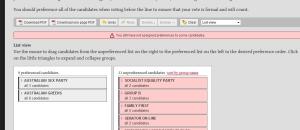Even though I’ve been trying to avoid all press, TV and radio coverage of the Federal Election to stop my brain from dissolving into a stew of catchphrases and jaunty anti-mining-tax jingles, I’ve found the online election coverage and discussion quite fascinating.
The 2007 election announced the coming of social media into Australian politics, with Kevin Rudd and John Howard trying to connect with first time voters by logging into MySpace, posting campaign announcements on YouTube and collecting friends on Facebook. Three years later, any excitement surrounding politicians using the Internet is dead, buried and cremated.
The article from the Australian, ‘Sorry, this isn’t the Twitter election’, describes the online campaigns of Julia Gillard and Tony Abbott which are, let’s face it, pathetic. Gillard’s advisors have tweeted on her behalf less than 20 times since July and Tony Abbott’s Facebook page hasn’t been updated since June. Since before the election was called. The most interesting thing on Facebook is the group with 50,000+ members, ‘Friends don’t let friends vote for Tony Abbott’, and they’re not doing much other than posting funny Abbott quotes.
Given the huge number of Australians on social media, this seems a great opportunity to use social media for something tangible, such as getting young people interested in voting, yet the mainstream media still holds the most political clout by a long way. A journalist asking Gillard about her education policy reveals a lot more than a tweet from one of her advisors pretending to be Gillard visiting a school. Until politicians advisors find a way to use it in an engaging way, there won’t be a ‘Twitter election’.
I have found some online political material which I think is quite interesting.
I was impressed by the ‘Women Speak Out” campaign from GetUp! (A political movement which tries to get issues into the mainstream media). While the video ad about Tony Abbott is interesting in itself, I find the campaign around it even more so. The organisation asks viewers to donate so that the ad can be shown on television, and at the time of this post, they had collected more than $150,000 in less than three days.
I think it touches on our topic for this week, the role of the “user” in Web 2.0, as an actor that enjoys participating in creating and publishing content. While GetUp! shot the ad, it is the users who give money and ultimately get the ad into the mainstream. They can feel part of the process and are probably more likely to help GetUp! again in the future, while GetUp! raises the money for ad space solely from its followers. It’s a different way of users acting than the purely creative users of YouTube and Flickr.
Another interesting possibility of the Internet in an election is getting people interested in voting and making their vote count, as demonstrated by the website Below the Line. I had this site recommended to me, and as an active participant in democracy, duly used it to plan my Senate vote on election day.
After selecting your state of residence you can plan what order to vote for senators on the massive Senate ballot card, create a personal PDF How to Vote card, print it out and take it into the polling booth. A quick Google search can tell you about each candidate and help you make an informed decision about who to vote for. This kind of thing was not nearly as simple and accessible a decade ago.
Even though elections and campaigning have not been revolutionised in the way we were promised, Web 2.0 has changed some aspects of Australian politics. At least it’s more than just Malcolm Turnbull tweeting about how nobody loves him.



Thanks for the detailed post. Getting people to vote in Australia is less critical than in other countries where it is not compulsory. But encouraging a more informed vote would be useful. I have found this election campaign to be the worst I’ve seen over the last few decades. Neither party has developed strong policy themes. The medium won’t overcome these kinds of deficiencies.
I think that is is painfully obvious in some political flirtations with social media that it is the PR people who are writing the updates on the politician’s behalf. It always comes across as a little forced. Or inaccurate. Politicians have not really mastered the appropriate voice that most people adopt for social media and they end up sounding a little awkward and like they are trying to be ‘down with the kids.’
I’m loving the way the Gruen Nation has been mocking the way politicians use Twitter with their live ‘tweets’ across the bottom of the screen during the program.
I agree that politicians are not taking advantage of social media. I did however, recently join Twitter and followed Julia Gillard. To my surprise, ‘she’ (and by she I mean her lackies) followed me in return. I don’t think this will sway my vote either way, but it did make me feel really special!
Since joining Twitter (See this week’s blog post) I have also started following Julia Gillard, but she (or her staff) has not said much. I’d highly recommended following the Crikey cartoonist’s ‘ABC Interpretive @DanceBandicoot’ instead, for in-depth analysis of the election campaign.